技术源于折腾,精于积累!
分类: JavaScript
2015-05-30 10:46:20
最通用的定义为:XmlHttp是一套可以在Javascript、VbScript、Jscript等脚本语言中通过http协议传送或从接收XML及其他数据的一套API。XmlHttp最大的用处是可以更新网页的部分内容而不需要刷新整个页面。
来自MSDN的解释:XmlHttp提供客户端同http服务器通讯的协议。客户端可以通过XmlHttp对象(MSXML2.XMLHTTP.3.0)向http服务器发送请求并使用微软XML文档对象模型Microsoft? XML Document Object Model (DOM)处理回应。 现在的绝对多数浏览器都增加了对XmlHttp的支持,IE中使用ActiveXObject方式创建XmlHttp对象,其他浏览器如:Firefox、Opera等通过window.XMLHttpRequest来创建xmlhttp对象。
XmlHttp对象的属性:

XmlHttp对象的方法:

如何发送一个简单的请求?
最简单的请求是,不以查询参数或提交表单的方式向服务器发送任何信息.使用XmlHttpRequest对象发送请求的基本步骤:
● 为得到XmlHttpRequest对象实例的一个引用,可以创建一个新的XmlHttpRequest的实例。
● 告诉XmlHttpRequest对象,那个函数回处理XmlHttpRequest对象的状态的改变.为此要把对象的
onreadystatechange属性设置为指向JavaScript的指针.
● 指定请求属性.XmlHttpRequest对象的Open()方法会指定将发送的请求.
● 将请求发送给服务器.XmlHttpRequest对象的send()方法将请求发送到目标资源.
XmlHttpRequest实例分析
我想大家都知道,要想使用一不对象首先我门得做什么?是不是必须先创建一个对象吧.比如C#和Java里用new来实例对象.那么我门现在要使用XmlHttp对象是不是也应该先创建一个XmlHttp对象呢?这是毫无疑问的!那么下面我们来看看在客户端怎么创建一个XmlHttp对象,并使用这个对象向服务端发送Http请求,然后处理服务器返回的响应信息.
1.创建一个XmlHttp对象(在这里我以一个无刷新做加法运算的实例 )
 var xmlHttp;
var xmlHttp; function createXMLHttpRequest()
function createXMLHttpRequest() {
{ if(window.ActiveXObject)
if(window.ActiveXObject) {
{ xmlHttp = new ActiveXObject("Microsoft.XMLHTTP");
xmlHttp = new ActiveXObject("Microsoft.XMLHTTP"); }
} else if(window.XMLHttpRequest)
else if(window.XMLHttpRequest) {
{ xmlHttp = new XMLHttpRequest();
xmlHttp = new XMLHttpRequest(); }
} }
}
2.定义发送请求的方法
 //处理方法
//处理方法 function AddNumber()
function AddNumber() {
{ createXMLHttpRequest();
createXMLHttpRequest(); var url= "AddHandler.ashx?num1="+document.getElementById("num1").value+"&num2="+document.getElementById("num2").value;
var url= "AddHandler.ashx?num1="+document.getElementById("num1").value+"&num2="+document.getElementById("num2").value; xmlHttp.open("GET",url,true);
xmlHttp.open("GET",url,true); xmlHttp.onreadystatechange=ShowResult;
xmlHttp.onreadystatechange=ShowResult; xmlHttp.send(null);
xmlHttp.send(null); }
}
3.定义回调函数,用于处理服务端返回的信息
 //回调方法
//回调方法 function ShowResult()
function ShowResult() {
{ if(xmlHttp.readyState==4)
if(xmlHttp.readyState==4) {
{ if(xmlHttp.status==200)
if(xmlHttp.status==200) {
{ document.getElementById("sum").value=xmlHttp.responseText;
document.getElementById("sum").value=xmlHttp.responseText; }
} }
} }
}
 <%@ WebHandler Language="C#" Class="Handler" %>
<%@ WebHandler Language="C#" Class="Handler" %>
 using System;
using System; using System.Web;
using System.Web; using System.Data;
using System.Data; using System.Data.SqlClient;
using System.Data.SqlClient;
 public class Handler : IHttpHandler
public class Handler : IHttpHandler  {
{
 public void ProcessRequest (HttpContext context)
public void ProcessRequest (HttpContext context)  {
{ context.Response.ContentType = "text/plain";
context.Response.ContentType = "text/plain"; int a = Convert.ToInt32(context.Request.QueryString["num1"]);
int a = Convert.ToInt32(context.Request.QueryString["num1"]); int b = Convert.ToInt32(context.Request.QueryString["num2"]);
int b = Convert.ToInt32(context.Request.QueryString["num2"]); int result = a + b;
int result = a + b; context.Response.Write(result);
context.Response.Write(result); }
}
 public bool IsReusable
public bool IsReusable {
{ get
get  {
{ return false;
return false; }
} }
} }
}
 <div style="text-align: center">
<div style="text-align: center"> <br />无刷新求和示例<br />
<br />无刷新求和示例<br /> <br />
<br /> <input id="num1" style="width: 107px" type="text" onkeyup="AddNumber();" value="0" />
<input id="num1" style="width: 107px" type="text" onkeyup="AddNumber();" value="0" /> +<input id="num2" style="width: 95px" type="text" onkeyup="AddNumber();" value="0" />
+<input id="num2" style="width: 95px" type="text" onkeyup="AddNumber();" value="0" /> =<input id="sum" style="width: 97px" type="text" />div>
=<input id="sum" style="width: 97px" type="text" />div>

 function CallBackObject()
function CallBackObject() {
{ this.XmlHttp = this.GetHttpObject();
this.XmlHttp = this.GetHttpObject(); }
}
 CallBackObject.prototype.GetHttpObject = function()
CallBackObject.prototype.GetHttpObject = function() {
{  var xmlhttp;
var xmlhttp; if (!xmlhttp && typeof XMLHttpRequest != 'undefined') {
if (!xmlhttp && typeof XMLHttpRequest != 'undefined') { try {
try { xmlhttp = new XMLHttpRequest();
xmlhttp = new XMLHttpRequest(); } catch (e) {
} catch (e) { xmlhttp = false;
xmlhttp = false; }
} }
} return xmlhttp;
return xmlhttp; }
}
 CallBackObject.prototype.DoCallBack = function(URL)
CallBackObject.prototype.DoCallBack = function(URL) {
{  if( this.XmlHttp )
if( this.XmlHttp ) {
{ if( this.XmlHttp.readyState == 4 || this.XmlHttp.readyState == 0 )
if( this.XmlHttp.readyState == 4 || this.XmlHttp.readyState == 0 ) {
{ var oThis = this;
var oThis = this; this.XmlHttp.open('POST', URL);
this.XmlHttp.open('POST', URL); this.XmlHttp.onreadystatechange = function(){ oThis.ReadyStateChange(); };
this.XmlHttp.onreadystatechange = function(){ oThis.ReadyStateChange(); }; this.XmlHttp.setRequestHeader('Content-Type', 'application/x-www-form-urlencoded');
this.XmlHttp.setRequestHeader('Content-Type', 'application/x-www-form-urlencoded'); this.XmlHttp.send(null);
this.XmlHttp.send(null); }
} }
} }
}
 CallBackObject.prototype.AbortCallBack = function()
CallBackObject.prototype.AbortCallBack = function() {
{ if( this.XmlHttp )
if( this.XmlHttp ) this.XmlHttp.abort();
this.XmlHttp.abort(); }
}
 CallBackObject.prototype.OnLoading = function()
CallBackObject.prototype.OnLoading = function() {
{ // Loading
// Loading }
}
 CallBackObject.prototype.OnLoaded = function()
CallBackObject.prototype.OnLoaded = function() {
{ // Loaded
// Loaded }
}
 CallBackObject.prototype.OnInteractive = function()
CallBackObject.prototype.OnInteractive = function() {
{ // Interactive
// Interactive }
}
 CallBackObject.prototype.OnComplete = function(responseText, responseXml)
CallBackObject.prototype.OnComplete = function(responseText, responseXml) {
{ // Complete
// Complete }
}
 CallBackObject.prototype.OnAbort = function()
CallBackObject.prototype.OnAbort = function() {
{ // Abort
// Abort }
}
 CallBackObject.prototype.OnError = function(status, statusText)
CallBackObject.prototype.OnError = function(status, statusText) {
{ // Error
// Error }
}
 CallBackObject.prototype.ReadyStateChange = function()
CallBackObject.prototype.ReadyStateChange = function() {
{ if( this.XmlHttp.readyState == 1 )
if( this.XmlHttp.readyState == 1 ) {
{ this.OnLoading();
this.OnLoading(); }
} else if( this.XmlHttp.readyState == 2 )
else if( this.XmlHttp.readyState == 2 ) {
{ this.OnLoaded();
this.OnLoaded(); }
} else if( this.XmlHttp.readyState == 3 )
else if( this.XmlHttp.readyState == 3 ) {
{ this.OnInteractive();
this.OnInteractive(); }
} else if( this.XmlHttp.readyState == 4 )
else if( this.XmlHttp.readyState == 4 ) {
{ if( this.XmlHttp.status == 0 )
if( this.XmlHttp.status == 0 ) this.OnAbort();
this.OnAbort(); else if( this.XmlHttp.status == 200 && this.XmlHttp.statusText == "OK" )
else if( this.XmlHttp.status == 200 && this.XmlHttp.statusText == "OK" ) this.OnComplete(this.XmlHttp.responseText, this.XmlHttp.responseXML);
this.OnComplete(this.XmlHttp.responseText, this.XmlHttp.responseXML); else
else this.OnError(this.XmlHttp.status, this.XmlHttp.statusText, this.XmlHttp.responseText);
this.OnError(this.XmlHttp.status, this.XmlHttp.statusText, this.XmlHttp.responseText);  }
} }
}
 <html xmlns="" >
<html xmlns="" > <head runat="server">
<head runat="server"> <title>HelloWorld实例title>
<title>HelloWorld实例title> <script language="jscript" src="CallBackObject.js">script>
<script language="jscript" src="CallBackObject.js">script> <script language=jscript>
<script language=jscript> function createRequest()
function createRequest() {
{ var name = escape(document.getElementById("name").value);
var name = escape(document.getElementById("name").value); var cbo = new CallBackObject();
var cbo = new CallBackObject(); cbo.OnComplete = Cbo_Complete;
cbo.OnComplete = Cbo_Complete; cbo.onError = Cbo_Error;
cbo.onError = Cbo_Error; cbo.DoCallBack("HelloWorldServer.aspx?name=" + name);
cbo.DoCallBack("HelloWorldServer.aspx?name=" + name);  }
}
 function Cbo_Complete(responseText, responseXML)
function Cbo_Complete(responseText, responseXML) {
{ alert(responseText);
alert(responseText); }
}
 function Cbo_Error(status, statusText, responseText)
function Cbo_Error(status, statusText, responseText) {
{ alert(responseText);
alert(responseText); }
} script>
script> head>
head> <body>
<body> <form id="form1" runat="server">
<form id="form1" runat="server"> <DIV style="DISPLAY: inline; FONT-WEIGHT: bold; FONT-SIZE: 30px; FONT-FAMILY: Arial, Verdana"
<DIV style="DISPLAY: inline; FONT-WEIGHT: bold; FONT-SIZE: 30px; FONT-FAMILY: Arial, Verdana" ms_positioning="FlowLayout">Hello, Ajax!DIV>
ms_positioning="FlowLayout">Hello, Ajax!DIV> <HR width="100%" SIZE="1">
<HR width="100%" SIZE="1"> <input type="text" id="name">
<input type="text" id="name"> <br>
<br> <input type="button" value="发送请求" onclick="javascript:createRequest()">
<input type="button" value="发送请求" onclick="javascript:createRequest()"> form>
form> body>
body> html>
html>